Nichole Louise's Blog, page 5
July 11, 2024
Review: The Temple of Fortuna by Elodie Harper
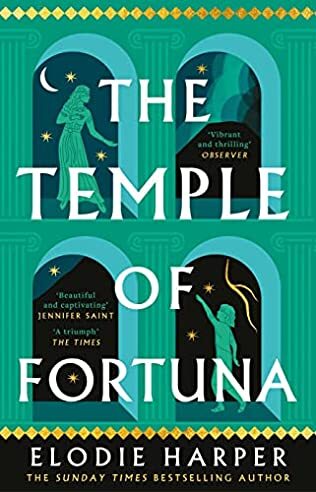
The Temple of Fortuna by Elodie Harper is the intense third installment of The Wolf Den trilogy. My reviews for books 1 and 2 can be found here and here. To be honest, I kind of put off reading this final installment because I knew it was going to be rough with the culmination of the stories and character arcs against the backdrop of the 79 AD Vesuvius eruption.
Temple opens three years after the events of book 2 with Amara living as a wealthy courtesan in Rome under her patron Demetrius. But when political ambitions and feuds threaten Amara’s safety, her patron sends her back to Pompeii with the expectation of their marriage later that year.
Amara is at once unseated by returning to Pompeii’s gritty streets where memories of trauma and abuse run wild. While she reunites with her former fellow “wolf”, the Iceni warrior Britannica who is now a gladiator, Amara also comes face to face with her past love Philos and their three-year-old daughter Rufina. They live at the estate of Julia Felix under the pretense the Philos, still enslaved, is Rufina’s caretaker while most believe she is the daughter of Amara’s former patron Rufus. Amara is at war with herself in her proximity to Philos, for it is clear she still loves him and he in turn, yet both know the utter danger involved in acting upon those feelings–especially with their daughter now in the mix.
Tremors rock Pompeii in growing frequency, and while the citizens shrug them off as normal, the reader will be feeling the heightened anxiety of what is to come. Amara briefly faces off with her old adversaries Felix and Victoria, now married, and worries her and Philos’ secret will come undone at Felix’s behest. All of these problems, however, will soon pale in comparison to the coming catastrophe that really hammers home the idea that many human problems and social constructions are trivial compared to the might and terror of nature.
About 60% through the book, the eruption begins. I will not give away too much, but rest assured I had to stop myself from binging the rest of the book in one sitting after this part because things move very fast and very intensely. Your heart races knowing what will happen on a grander scale, yet aches for the characters and their possible fates. Will all their struggles be for naught, or will they–against all odds, find their happy ending after all? Again, I don’t want to give away too much, but I found the end both surprising and satisfying. The Temple of Fortuna is a wonderful conclusion to this amazing trilogy filled with complex and nuanced relationships, characters, and social structures.
Below, please find a few choice photos from my own visit to Pompeii in 2022. It was both magical and eerie at dusk.
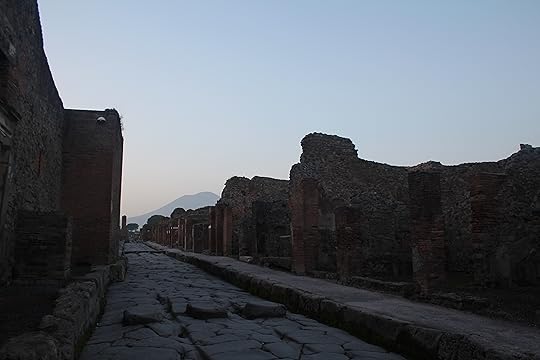
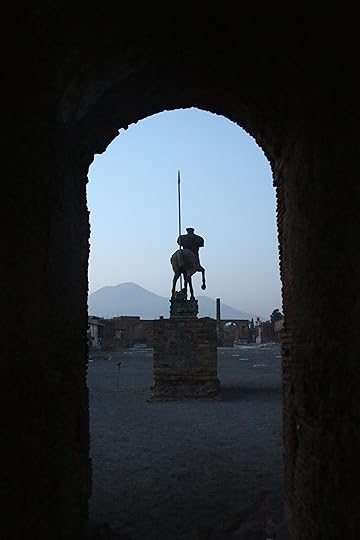
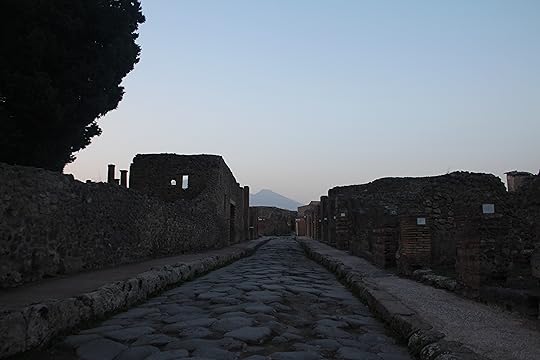
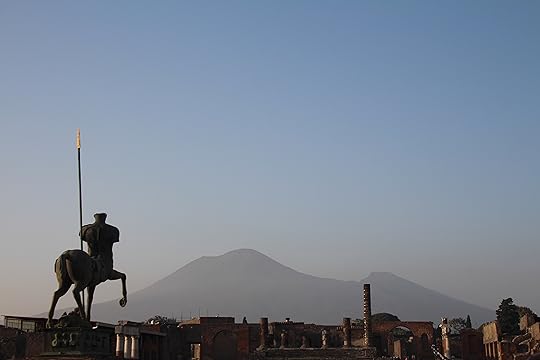
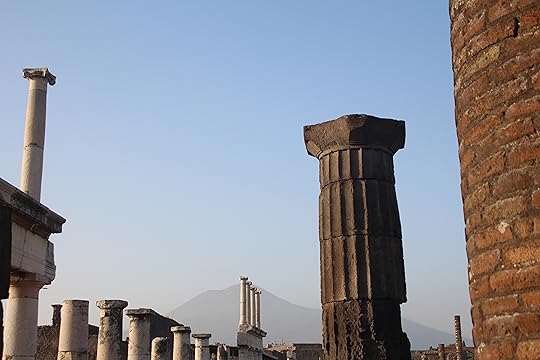

July 3, 2024
Review: A Lady by Hannah Honegger

For fans of TURN, A Lady by Hannah Honegger (re)imagines real life anonymous Cipher 355 of the Culper Ring (General Washington’s spy network) as Mary Andre, sister of British officer Major John Andre. Already being such a fan of TURN and America Revolution history, I was immediately on board with this book which turned out to be a fast, fun, and entertaining read.
Witnessing the actions of the British army occupying Philadelphia, Mary Andre flees her home of comfort and luxury and soon finds herself in the camp of the Continental army. Reading about historic Philadelphia is always a treat for me specifically because I live here and have walked many times among the historic locales mentioned (Old City, Germantown, Valley Forge, etc.)
Using the false surname of Floyd, Mary must prove her loyalties have changed to ally with the rebels by revealing her true identity to officer Ben Tallmadge to offer important information she overheard as the sister of a British officer. Earning the trust and respect of the Continentals and the women camp followers at Valley Forge proves to be a challenge for Mary, and she is tested both mentally and physically on the new and treacherous path she has chosen.
I loved the evolving relationship between Ben and Mary, and Hannah Honegger expertly draws out the tension between them which makes this story a page turner. The author’s choice to make their relationship a slow burn, with Ben Tallmadge being very reticent about Mary and his involvement with her given his occupation, was believable. I found myself quickly invested in Mary’s journey, not just across Philadelphia and the surrounding area, but also her psychological journey of choosing such a different and dangerous path than what as previously laid out for her.
The sequel to A Lady, entitled A Spy, is scheduled to be released November 2024!
June 25, 2024
Review: The Caricaturist by Norman Lock
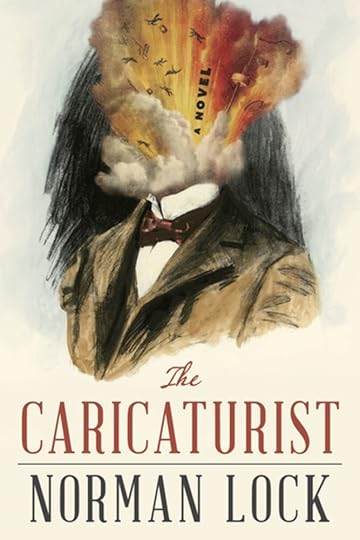
Oliver Fischer, a self-styled bohemian, boardwalk caricaturist, and student at the Pennsylvania Academy of the Fine Arts, enrages his banker father and earns the contempt of Philadelphia’s foremost realist painter Thomas Eakins when he attempts to stage Manet’s scandalous painting The Luncheon on the Grass. Soon after, he is ensnarled, along with Mark Twain and Andrew Carnegie, in a clash between the Anti-Imperialist League and their expansionist foes. Sent to Key West to sketch the 1898 American invasion of Cuba, in company with war correspondent Stephen Crane, he realizes––in the flash of a naval bombardment––that our lives are suspended by a thread between radiance and annihilation.
I usually don’t include the official blurb of a book in my reviews, but I am here because this one paragraph basically tells you the entire plot of The Caricaturist by Norman Lock. That statement is no hyperbole. That’s really all that happens! I went into this book thinking I would get an interesting account of an artist war correspondent covering the now little known 1898 American invasion of Cuba. In truth, the main character Oliver Fischer does not even make it to Key West until about 80% into the book.
Being from Philly, it was fun to read descriptions of the city and be able to orient myself on the streets the characters walked and the landmarks they passed. Logistically, Lock got things mostly accurate–except there was mention of Chinatown starting around 6th St. To my knowledge, Chinatown has historically never extended to 6th street, but started around 9th/10th which is where is remains today.
To be honest, not much happened in this book which made reading it a bit of a slog. I considered DNFing it a few times, but figured I’d push through hoping we’d get to the action of Cuba. In reality, the majority of the book follows Oliver and his friends bumbling around Philadelphia eating, drinking, drawing, and briefly getting caught up in anti-Imperialist protests. There were some humorous moments, but for the entirely of the book I was just waiting for something to happen to propel the plot forward. I suppose I felt this way because the stakes weren’t high. Oliver is relatively privileged and although his father threatened to cut him off financially if he continued bumbling about with his “frivolous sketching,” I never really got the impression that Oliver was ever in any danger of succumbing to dire circumstances. By the time we get to the precipice of action in Key West 80% into the book, the story pretty much abruptly ends before Oliver even gets Cuba to become an artist war correspondent!
The Caricaturist will be released July 2, 2024
June 18, 2024
Review: Freeman’s Challenge by Robin Bernstein
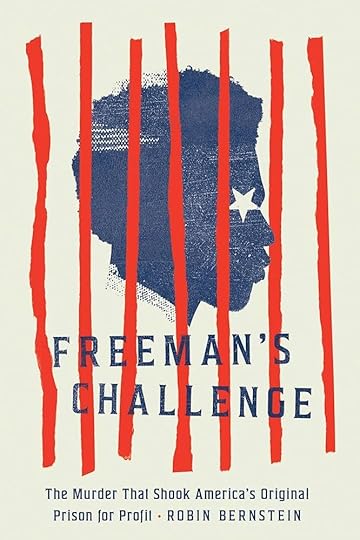
Freeman’s Challenge is an informative and educational piece of historical work that explains the one of the first for-profit prisons and a brutal murder of a family that shook the town of Auburn in New York. I greatly appreciated Robin Bernstein’s opening chapter regarding the contextual history of the land that would become Auburn. Bernstein cites a little known, but very significant campaign during the American Revolution known as the 1779 Sullivan Campaign. In this campaign, George Washington ordered the destruction of all Haudenosaunee villages allied with the British (all of the Haudenosaunee tribes except the Oneida, who allied with the Continentals.) The land of one Cayuga village, after its destruction, was purchased by a soldier who had taken part in the Sullivan Campaign. This land would become the town of Auburn, with one of its main features being a prison (and subsequent style of prison system,) which by 1823 would “directly and indirectly infuse Auburn with the equivalent of two million dollars of today’s dollars.” (p. 13) Bernstein goes on to explain that “white entrepreneurs and politicians of Auburn accomplished…a prison [planned] around factories, in relation to their [river] power source, with the purpose of enriching a town, its businesses, and its businessmen…They viewed a prison as a vehicle by which to soak up state funds, build banking, stimulate commerce, manufacture goods, and develop land and waterways. In short, they reimagined the prison as an infrastructure for capitalism.” (p. 13)
William Freeman was a young Afro-Indigenous man from Auburn. He was accused of stealing a white woman’s horse and thrown into the Auburn prison. Throughout his incarceration, Freeman was adamant that he had not committed the crime. In turn, he resisted doing the forced labor the inmates were tasked with. He often told the guards and supervisors that he would not work if he was “deriving no benefit” from the labor–i.e. receiving pay. Always standing up for his innocence, Freeman was subjected to cruel punishments such as the “shower bath,” which is essentially a form of waterboarding. One such incidence of Freeman’s resistance resulted in one of the guards beating him with a board across the head. Freeman suffered a life-changing blow to the head which resulted in loss of hearing in one ear and a nasty concussion which likely lead to lifelong cognitive problems.
After five years of incarceration, Freeman returned home to find work to no avail. His family members found him much changed no doubt due to the abuse he suffered in Auburn Prison, but also due to the severe head injury that had left him cognitively changed. Freeman grew frustrated in trying to find work and began to repeat his earlier claims that he should have been paid for his time working in Auburn Prison. Bernstein explains that Freeman’s claims to receive pay were not as outlandish as some believed in that “practices for paying incarcerated people were well established in the United States. Since 1699, American Houses of Correction and later carceral systems had developed ways for prisoners to earn money in captivity…the most widespread mechanism was called overstint. In this system, an incarcerated person was required to labor a set amount of time or until a predetermined amount of work was accomplished–and any work beyond that “stint” earned money for the prisoner.” (p. 78) Because Auburn State Prison had been conceived and operated in ties with the local economy in exploiting prisoners for profit, they inherently did not pay the incarcerated individuals laboring inside its walls.
Freeman’s frustration and anguish came to head when he decided to “make someone pay” for what he was owed. The result was a shocking and seemingly random murder of the local Van Nest family that shook not just Auburn, but the state of New York and beyond. The press attention on the case drummed up racist theories and rhetoric, many people often attributing Freeman’s capacity to commit murder to his Afro-Indigenous heritage. Many could not accept that Freeman did not have an ulterior motive other than “someone had to pay” for what he had been through and to receive what he was owed.
William Henry Seward would later represent Freeman in court, his main argument being that “Freeman had become insane because of excessive violence [endued in prison], particularly the head injury.” (p. 135) Bernstein offers a balanced view of these historical events, allowing the reader to ruminate on violence begetting violence, of malice not being born but being created–a product of an abusive and exploitative system already operating on racist and colonial ideals interwoven with the industry of the mid 19th century.
June 11, 2024
JAR Review: The Unexpected Abigail Adams by John L. Smith, Jr.
June 7, 2024
Review: What They Said About Luisa by Erika Rummel
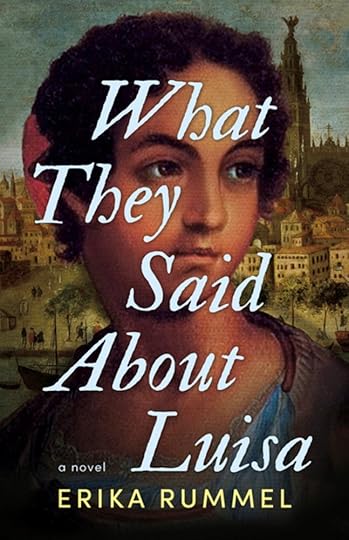
What They Said ABout Luisa by Erika Rummel imagines a backstory for a real 16th century woman named Luisa Abrego, an enslaved woman of “Moorish” heritage in Seville who had been set free upon her master’s death. Upon manumission, he also allegedly gave her a sum on which to live. Luisa then journeyed to Zacatecas, Mexico with her new husband to try to make a life there. While her husband worked the silver mines, Luisa became an successful embroiderer. Luisa was later caught up in Spain’s Inquisition in Mexico City where she was accused of bigamy. While historical record loses track of the real Luisa, Erika Rummel fleshes out this interesting story pulled from true accounts.
While Luisa is presumably the main character and subject of this story, we don’t actually get her POV. Not once. As noted by the title, all chapters of the novel are from everyone else’s perspectives of Luisa (mostly men.) There were a few reoccurring POVs such as her husband Jorge, but sometimes there would be a POV chapter from someone a bit far removed from Luisa and her situation. I know these perspective changes were perhaps the point of the novel, given the title, but honestly I would have much rather read a story from Luisa’s perspective. I wasn’t super interested in reading what men, close or far from her, had to say about her or speculate about her, as their thoughts were often sexist, racist, and classist. Maybe that was the point, but without the balance of Luisa’s own perspective, to me that doesn’t make the story engaging. The only truly engaging and interesting POV chapter came about 80% into the book with Luisa’s long lost eight year old son who had been raised in a convent in Spain.
While I stuck it out to the end, ultimately I wasn’t interested or invested in what “others had to say about Luisa.” I would have rather heard it from her!
What They Said ABout Luisa will be released June 18, 2024
April 29, 2024
Review: The Familiar by Leigh Bardugo
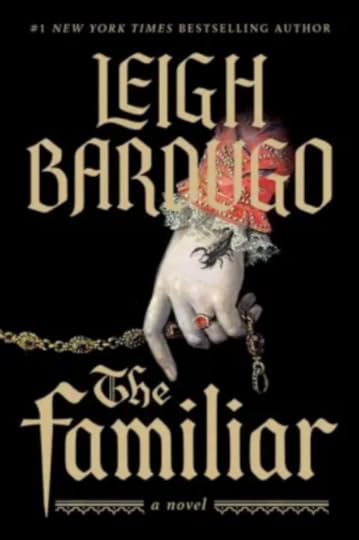
The Familiar by Leigh Bardugo is an enchanting tale set in 16th century Spain. Luzia Cotado is a scullion of secret Jewish heritage. Protecting her true lineage in a country ruled by the Inquisition requires Luzia to keep a low profile. Although well-read, intelligent, and witty, Luzia must play the part of the illiterate, dull scullion to retain her safety. What makes Luzia’s situation even more precarious is her ability for small magical acts: un-burning bread, fixing broken glasses, making plants grow…
Yet Luzia’s small acts of magic soon catch the eye of her master, Valentina, and she is subsequently put on display to Madrid society to demonstrate her magic. Luzia is but a bargaining chip in Valentina’s desire to climb the social ladder, yet the attention upon Luzia grows as she attracts the attention of men of influence. Her aunt’s lover, the inexplicably lucky and powerful Victor de Paredes becomes Luzia’s patron with the aim for Luzia to be entered into the holy torneo to display her talents for the king. Paredes’ true aim, of course, is to wield power and influence over the king through Luzia’s abilities, or “milagritos.” Paredes’ servant, the mysterious and enigmatic white-haired, silver-eyed Santangel becomes a sort of magical tutor to Luzia.
Santangel and Luzia form a unique bond, her power magnified by his unexplainable history. In time, he reveals his own impossible secrets. He is Luzia’s shadow and protector during the torneo entailing three trials in which Luzia must compete against three other competitors with their own unique abilities (some real, some illusion.) Bardugo is also careful to give Luzia her own agency and ability to save herself rather than be saved by a man, while still leaving the reader satisfied with the equitable relationship between Santangel and Luzia.
The Familiar is actually the first book I’ve read by Leigh Bardugo, and I now understand why people love her work. In this tale, she has woven an engaging narrative and complex characters in combination with bite sized chapters to keep the pace moving as well as keeping the reader guessing. The Familiar does not romanticize or gloss over the darkness of power and men who would wield it, of violence, of self preservation vs. selflessness. Quite honestly, I did not want this story to end. And although The Familiar is self-contained, I would love to see more of Santangel and Luzia. That said, the end of The Familiar is absolutely beautiful.
April 26, 2024
Review: Blood Runs Coal by Mark A. Bradley
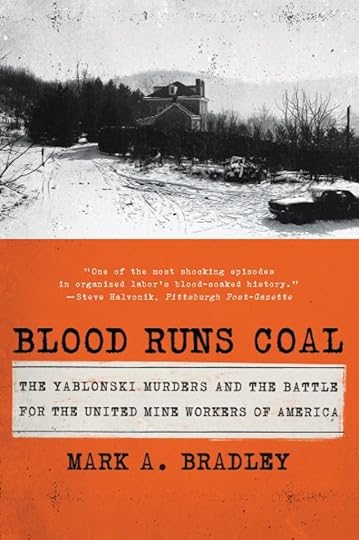
Blood Runs Coal: The Yablonski Murders and The Battle for the United Mine Workers of America by Mark A. Bradley is a non-fiction account of the 1969 murder of Mine union leader in running Jock Yablonski and his family in Clarksville, PA. Bradley’s account of the inner political machinations of the Miner Unions in coal country is engaging and accessible –two key points in making non-fiction easier to read. Born and raised in PA, I was interested to learn about this incident in my state’s history as I had not heard of it before.
The murder of Jock Yablonski and his family was planned by Tony Boyle, the Union’s leader and opposition to Yablonski. While Boyle and his cronies enjoyed raking in embezzled funds and padded salaries at the expense of mine safety and regulations, Yablonski actually ran on a platform of walking the walk–not just talking and talk like Boyle. Yablonski’s integrity and desire to truly better the Union and life for its workers was a direct threat to Boyle and his cronies, and the cushy incomes they had been receiving uncontested for years. Boyle enlisted numerous parties to execute his wishes; various middlemen through which to launder money, arrange the assassination details, and employ hit men for hire. Interestingly enough, and perhaps unsurprising, the hit men were quite easy to “break” in terms of ratting out who had hired them. From there, the dominoes fell fast and hard, all the way up to Tony Boyle himself.
Blood Runs Coal is a gritty, engaging read about the violent machinations and power grabs of the United Mine Workers of America, and in turn, the exploitation of its workers at the expense of their very lives and safety. It also reads along the same lines as Truman Capote’s In Cold Blood.
April 16, 2024
Review: The Diamond Eye by Kate Quinn
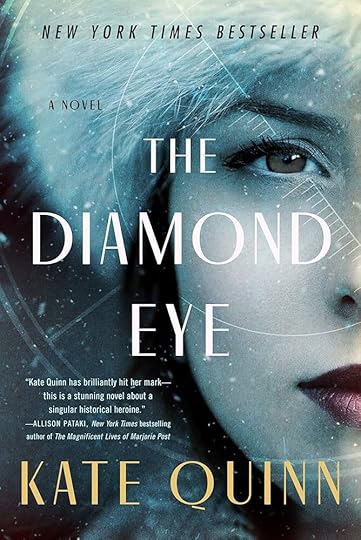
The Diamond Eye by Kate Quinn follows the rise of Lyudmila Pavlichenko ,”Lady Death”, famed Soviet Sniper of WWII with an official kill tally of 309. I first heard about Lyudmila (“Mila”) during my early – mid ’00s Russian history obsession phase of my life (everyone has one of those, right…?) A woman fighting on the front lines during WWII? I was instantly captivated and always thought her life would make a fascinating movie or book. And lo and behold, the fabulous Kate Quinn has done just that.
Quinn points out in her author’s note that Mila’s own memoir is fact based, devoid of much emotion, and had the stamp of approval from the Soviet propaganda powers that be. In turn, Quinn wanted to explore the hidden life of Mila–the emotions buried deep within the woman who outsiders at the time could only assume was a cold blooded killer. The reader first meets Mila as a young mother (she was 15 when she had her son) in college studying history, taking shooting courses on the side. Mila is studying in Odessa when the war breaks out and although she is loathe to leave her son, she immediately enlists due to her shooting skills.
Mila’s mantra throughout The Diamond Eye is “Don’t miss.” For her, that mantra is not just about the target, but everything in her life. While Mila has honed her craft as a sharpshooter, she constantly must prove herself again and again, even on the front line of battle, to her superiors that she is in fact capable and skilled in her role. Quinn’s descriptions of the quiet rage of women in these settings are absolutely on point.
What I loved most about The Diamond Eye was Mila’s relationships: Lena, the first woman she encounters at the front who works in the Medical corp, Kostia her dark and myserious Siberian sniper partner, and Lyonya a Lieutenant in her company with who she forms a fast and wildly romantic bond amidst the backdrop of war. Readers will also love to hate Mila’s ex and father of her child, the narcissistic army surgeon Alexei Pavlichenko. Quinn excels in fleshing out these relationships against the high stakes backgrounds of the Siege of Odessa and the Battle of Sevastopol. I found myself really caring about these characters and thinking about them/the real people behind them even when I wasn’t reading. That’s when you know a writer has done her job well!
The Diamond Eye also recounts Mila’s time in Washington DC in 1942, drumming up support for the Soviets with the hopes of Roosevelt opening a second front. Mila, in the book and in real life, befriended Eleanor Roosevelt. Their friendship is both unexpected and intriguing–and Eleanor even visited Mila fifteen years later on a goodwill mission to the USSR. At first I wasn’t super keen on the narrative switching back and forth from Mila at the front to Mila in DC, but that story line eventually grew on me. The behind the scenes story points that happen amidst the DC events perhaps ask the reader to suspend her disbelief at times, but the occurrences round out Mila’s character arc. I can’t say enough good things about The Diamond Eye!
March 27, 2024
Review: Starship Troopers by Robert A. Heinlein
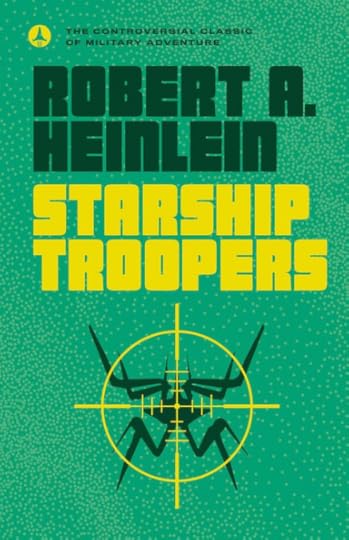
Like many, I know Starship Troopers from the cult classic 1997 movie. Although the movie is campy and satirical fun, the premise and world building is interesting and so I was curious how different the original book would be. While there are similarities in general strokes, the book is a lot less narrative in both story and structure than the movie.
Juan “Johnnie” Rico feels a bit directionless as he approaches high school graduation, yet his friend Carl is enthusiastic about joining the service. Johnnie goes against his parents’ wishes and enlists with Carl, yet after aptitude testing, is placed “low” with the Mobile Infantry. Johnnie admits he is pretty normal to average in academics, and while he is at first surprised that he placed low on many of the military’s aptitude tests, he commits to putting his all into training for the MI.
Many chapters of Starship Troopers read almost as self-contained vignettes on topics such as discussions in Johnnie’s Moral History and Philosophy class, the brutal rigors of basic training, how the MI combat suits operate, a chapter(and a half?) on Johnnie studying Math for his officer training, to a bizarre and seemingly out of place chapter advocating for physically disciplining children. The side characters we know from the movie: Carl, Carmen, & Dizzy (a man in this,) are mentioned a few times each without much back story or build up. To be fair, the movie is a little better about attempting to fully realize each of these four characters, whereas the book only focuses on Johnnie’s POV. And to go further, the movie is actually better at satire and about driving home the whole fascist regime exploiting its people by requiring military service for citizenship thing.
Heinlein focuses more on the technical aspects of this world, as well as the military structures and chains of command (these in depth description are quite dry.) The characters and their stories very much came secondary to those pieces of world building. There are a few nuggets of wisdom along the lines of history repeating itself and war is both brutal and necessary for powerful regimes, but substance falls short in the wake of technical minutia. As such, I felt mostly detached reading Starship Troopers, which was a little disappointing as I was wanting more action and character building scenes as well (Klendathu isn’t even mentioned until half-way through the book.)




